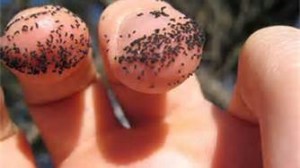Mold Springtails and Ants in The Home.
Our mold inspector once received a call from a potential mold inspection client. The client feared that she had mold hidden in her bathroom walls. She was concerned about hidden mold because a mold inspector told her that the ants in her bathroom were an indication of hidden house mold. As a result, he recommended further mold testing because according to him “ants eat mold.”
Forget About House Ants as A Sign of Mold
Do not depend on ants to let you know if you have mold in your house. More importantly, do not rely on a mold inspector who mistakenly looks to ants to let him know if you have mold. Most importantly, never trust a mold inspector who tells you that you need a 2nd, more qualified mold inspector to finish the inspection job he started.
Ants as A Sign of Wood Decay
Carpenter ants can be a sign of wood decay; they love to live inside rotten wood inside walls. Rotten wood may have some wood decay fungi in it. It may be very slightly moist. This is not necessarily a true mold problem; it just constitutes bug infested rotten wood.
Ants are likely a sign that you have scraps of food, or droplets of water in the house. Often, the ants find the water around a kitchen or bathroom sink, and not from a leak.
In conclusion, in Florida, ants are not a sign of mold infestation. Ants are not big consumers of mold in our area.
What About Leaf Cutter Ants
Some ants eat mold, but these ants are not found in our homes. They do not even live in the United States. These specialized ants called leaf cutter ants live in large underground colonies in the jungles of Central and South America. Furthermore, these ants do not enter people’s homes looking for mold. They tend to their own private underground mold farms. The ants cultivated fluffy white mold that grows on leaves they cut. They only consume the mold that they raise in underground mold farms. In addition, these ants only cultivate and eat a very few specific species of mold.
If there are any ants in Florida that routinely are associated with house mold, I have never seen them. Despite having done home inspections since 1993 and mold inspections since 2003 I have seen no ant and mold correlations. I have seen lots of homes, lots of mold, lots of ants, and very rarely have I seen ants in the vicinity of the mold.
Most ants probably don’t like house mold any more than humans do. The natural mycotoxins, and volatile organic compounds mold produces likely is a mild deterrent. In fact, it is predators such as ants, other insects, and microbes, that prompt molds to produce many of the defensive mold toxins some house molds produce.
What About Springtails and Mold AKA Carambola.
Are Springtails A Sign of Mold?
It is very true that spring-tails also known as carambola are often a sign of mold in the home. Mold and springtails do have a correlation. In fact, I have seen spring-tails in moldy homes several times. These extremely tiny insect like creatures are very often closely associated with serious house mold problems. I can remember seeing them once in a moldy AC unit in Lake Worth on Lake Worth road, and another time behind baseboards in a moldy guest house in West Palm Beach.
I have found springtails associated with mold under the floors of an expensive condo on Key Biscayne. In this Key Biscayne property, spring-tails were between the floor boards, and the mold was under and between the floor boards.
I have seen spring-tails under the microscope with Chaetomium spores and Pen Asp spores inside their intestine. This is because these bugs are almost microscopic in size and fill their bellies with mold spores. Because they are so tiny, you can see spores through their thin skin under the microscope.
I have personally raised large tropical spring-tails as food for dart frogs. I fed the spring-tails mold and yeast in decaying organic matter. Thus, considering all the above, I can confidently say that spring tails are an indicator of mold.
Problem to Using Springtails as a Mold Indicator
The problem with spring-tails as a sign of fungal contamination in a building is firstly, they are so tiny that they are almost impossible to see, the secondly, most homeowners, home inspectors, and even mold inspectors have no idea what a spring-tail is, or have a hard time seeing these super tiny arthropods. Because of their small size, even these common prolific mold eaters are not the best red flag to look for when identifying mold problems.

Springtails actual size. The local Florida ones are typically white and very hard to see. Often found in forest leaf litter and inside decaying seed pods outside. Sometimes found behind moldy baseboards, in moldy cabinets, and on moldy walls in homes.
Other Arthropods That Associate With Mold or Moisture.
Booklice
Booklice also known as Psocids occur in moist and moldy areas. They are found both indoors and outdoors. They are known as booklice due to their association with books. The reason they are associated with books is because a common food source for them is the glue that bind book pages together. Perhaps, in some areas, these insects may be associated with mold growth. However, In South East Florida, I never find them in moldy homes.
Silverfish
Silverfish are another insect that are sometimes found in humid or moist indoor environments. They have a varied diet, however, in homes they often feed on paper. A clean sign of silverfish is the presence of dozens or even hundreds of small irregular shaped holes in paper. Another indication is the presence of thousands of droppings that resemble termite droppings.
In my personal experience as a mold inspector, silverfish are typically in attics where they love to feed on the paper backing attached to fiberglass batt insulation. Silverfish also often feed on drywall paper that is attached to drywall. In South Florida I do not find silverfish around moldy attic insulation, nor around moldy drywall. They just seem to proliferate in many attics with some humidity.
Fungus Mites
Fungus mites have a strong correlation with mold. In fact they eat mold and live in it. Hundreds of them will live in a patch of mold. Being arachnids they resemble ticks, however, they are about the size of a dust mite, perhaps a little larger, thus are too small to easily see with the unaided eye.
Thus, though they are often around mold, they are not a good visual indication of mold.
Fungus Gnats
Fungus gnats are small weak flying insects that resemble a cross between a fly and a mosquito.
The young live in wet soil and decaying organic matter where they feed on mold.
I don’t find these in moldy homes often, but may have seen a very few over the years in sewage flooded homes, and highly neglected and long abandoned water damaged homes.
Fungus gnats are not strongly associated with mold homes because the young need wet moldy dirt or rotten plant material to reside in. You are more likely to find fungus gnats around failing flooded drain fields where the soil is saturated with sewage.
Where fungus gnats are most often found is in association with wet plant nursery soil. They are a common and problematic pest around overwatered plants. Fungus gnat larva live in wet potting soil, and can sometimes cause damage or death to overwatered plant seedlings.
For more info on bugs that are associated with mold or moisture in the home click here.
CONCLUSION
Do not rely on hungry ants, nearly microscopic spring-tails, nor mis informed mold inspectors to locate mold in your home. Hire a professional certified and licensed mold inspector who utilizes moisture meters, humidity meters, borescopes, and air testing to find mold. Most importantly your mold inspector must use common sense, knowledge, and experience to detect mold problems in your home.



